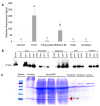Comparative Evaluation of Transient Protein Expression Efficiency in Tissues across Soybean Varieties Using the Tsukuba System
- PMID: 38592852
- PMCID: PMC10975771
- DOI: 10.3390/plants13060858
Comparative Evaluation of Transient Protein Expression Efficiency in Tissues across Soybean Varieties Using the Tsukuba System
Abstract
Transient protein expression is a versatile tool with diverse applications and can be used in soybeans to study gene function, obtain mutants, and produce proteins for commercial use. However, soybeans are considered recalcitrant for agroinfiltration. Subsequent studies on soybeans have demonstrated a green fluorescent protein (GFP) expression in seedpods, but not in leaves, using syringe agroinfiltration. To evaluate agroinfiltration-based transient protein expression levels in plant cells, we used the transient expression vector pTKB3 harboring the GFP gene. Using Agrobacterium tumefaciens, vacuum agroinfiltration of the leaves and needle agroinfiltration of the seedlings of different soybean varieties were performed. GFP was transiently expressed in all of the samples. However, the Enrei and Williams 82 varieties presented better results than the other varieties in the leaf tissue, with results confirmed by immunoblot analysis, demonstrating that both varieties are good candidates for molecular biological studies. GFP expression in the seedlings was less extensive than that in the leaves, which may be due to the tissue characteristics, with Enrei showing the best results. Based on this observation, we conclude that the Tsukuba system is an effective tool that can be used for different tissues and soybean varieties.
Keywords: GFP; Glycine max; agroinfiltration.
Conflict of interest statement
The authors declare no conflict of interest.
Figures





Similar articles
-
Agroinfiltration-based efficient transient protein expression in leguminous plants.Plant Biotechnol (Tokyo). 2019;36(2):119-123. doi: 10.5511/plantbiotechnology.19.0220b. Plant Biotechnol (Tokyo). 2019. PMID: 31768113 Free PMC article.
-
Development and optimization of agroinfiltration for soybean.Plant Cell Rep. 2015 Jan;34(1):133-40. doi: 10.1007/s00299-014-1694-4. Epub 2014 Oct 19. Plant Cell Rep. 2015. PMID: 25326714
-
A simple and efficient agroinfiltration method for transient gene expression in Citrus.Plant Cell Rep. 2021 Jul;40(7):1171-1179. doi: 10.1007/s00299-021-02700-w. Epub 2021 May 4. Plant Cell Rep. 2021. PMID: 33948685
-
Xcc-facilitated agroinfiltration of citrus leaves: a tool for rapid functional analysis of transgenes in citrus leaves.Plant Cell Rep. 2014 Dec;33(12):1993-2001. doi: 10.1007/s00299-014-1673-9. Epub 2014 Aug 22. Plant Cell Rep. 2014. PMID: 25146436
-
Leaf infiltration in plant science: old method, new possibilities.Plant Methods. 2021 Jul 28;17(1):83. doi: 10.1186/s13007-021-00782-x. Plant Methods. 2021. PMID: 34321022 Free PMC article. Review.
References
-
- Jiang G., Chen P., Zhang J., Florez-Palacios L., Zeng A., Wang X., Bowen R.A., Miller A., Berry H. Genetic Analysis of Sugar Composition and Its Relationship with Protein, Oil, and Fiber in Soybean. Crop Sci. 2018;58:2413–2421. doi: 10.2135/cropsci2018.03.0173. - DOI
Grants and funding
LinkOut - more resources
Full Text Sources

